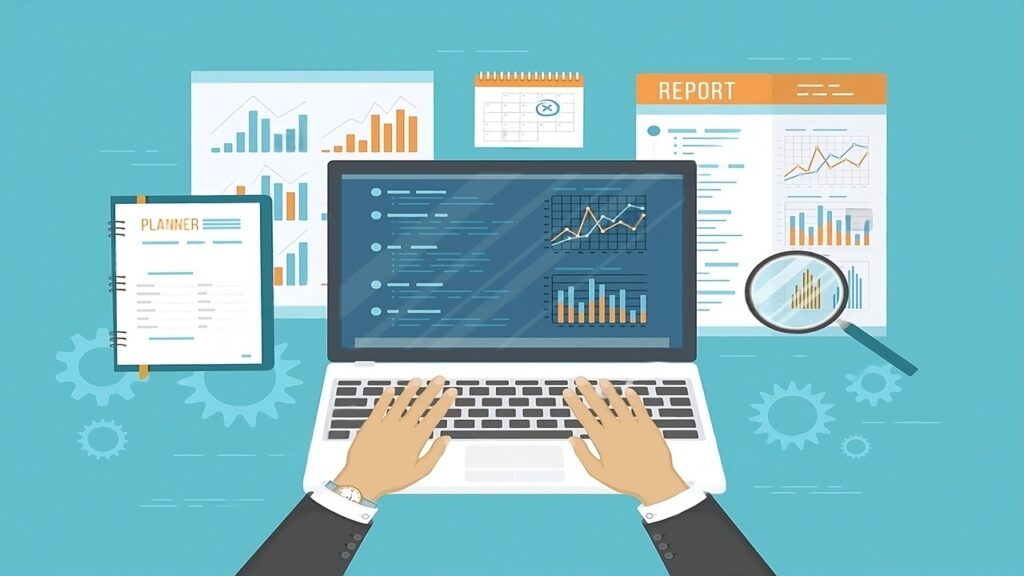
It’s important to know how your firm is doing financially. To achieve that well, you need the correct financial analysis tools for analyzing finances.
These technologies turn complicated financial information into straightforward, useful information.
No more fighting with complicated spreadsheets and doing math by hand.
Financial analytics software and financial reporting tools give you quick access to the most important numbers that keep your organization running.
It’s easy to keep track of your income, spending, and earnings. It’s easier to spot financial trends, which helps you make better choices.
In the end, these tools let you understand and control how well your organization is doing financially.
This post will talk about some of the top financial analysis tools available today and how they help businesses make decisions based on data that help them grow.
Table of Contents
ToggleWhat Are Financial Analysis Tools?
The goal of financial analysis tools is to make it easier to understand your financial data.
They gather, sort and analyze statistics to let you see how your business is doing financially.
You can keep an eye on your cash flow, balance sheets and income statements all in one place with these tools.
They give you a full picture of your business’s financial health.
Financial analysis softwares automates numerous tasks, so you don’t have to spend hours doing math by hand.
This speeds up your decision-making, cuts down on mistakes and saves you time.
There are tools for firms of all sizes and levels of sophistication, from simple templates to more comprehensive software solutions.
Each tool makes it easier to analyze and report on your finances.
Why Financial Analysis Tools Are Essential for Your Business
Financial analysis tools are not just nice to have; they are necessary.
It’s easy to make mistakes when handling financial data if you don’t have the necessary tools.
These tools let you find patterns, keep an eye on trends and find problems before they get too big.
Here are some important reasons why your firm requires them:
- Save Time: Automation cuts down on the time spent entering data and doing computations by hand.
- Make it More Accurate: Automated technologies cut down on mistakes people make in financial reports.
- Make Smart selections: Having access to data in real time helps you make quick and sure selections.
- Improve Profit Margins: Knowing your costs and sales lets you better manage your margins.
It’s not safe to rely on guesswork in a market with a lot of competition.
You may remain ahead by using financial analysis tools to get a better perspective.
Tip: When picking financial analysis softwares, make sure to choose solutions that work well with your current accounting systems. This cuts down on duplicate data entry and makes sure that financial information is always up to date on all platforms.
The best financial analysis tools for your business
Below are some of the best financial analysis programs that offer a wide range of functions, from basic reporting to more complex analytics.
| Tool | Best For | Key Features |
| QuickBooks | Small businesses | Expense tracking, basic reporting, profit/loss |
| Xero | Growing businesses | Real-time dashboards, comprehensive reports |
| Tableau | Data visualization | Converts data into charts and graphs |
| Microsoft Power BI | Mid to large firms | Advanced analytics, customizable dashboards |
These tools help businesses reduce costs, improve operations and plan for sustainable growth.
Important Things to Look for in Financial Analytics Software
Not all financial analytics software has the same features.
Choosing the appropriate one entails looking for characteristics that help you reach your business goals.
1. Updates to data in real time
Financial information is only useful if it is up to date.
Find tools that give you real-time data updates so you can make decisions based on correct information.
2. Customizable Dashboards
Your business measurements are one of a kind.
Pick software that enables you to customize dashboards to show key performance indicators (KPIs) including cash flow, profit margins and costs.
3. Data Visualization
Just looking at numbers can be too much.
Charts and graphs help you understand data better and find trends faster.
Financial Forecasting and Integration
Financial Forecasting
A solid financial analysis tool uses past data to make predictions about future trends.
This helps you make budgets, keep track of your financial flow and plan your investments.
Tip: Buy financial analysis software that lets you add more features as you need them. As your firm grows, being able to integrate new systems easily will save you time and keep data from becoming stuck in expensive silos.
Financial Reporting tools: Making Data Useful
To know how healthy your business is financially, you need financial reporting tools.
They make it easy to keep track of sales, costs and profits.
Some important benefits are:
- Keeping an eye on important parameters that affect ROI
- Automating report production to save time
- Making things clearer so that decisions can be made more easily
- Helping with tax compliance and audits
Comparison of Financial Analysis Tools Features
| Feature | QuickBooks | Xero | Tableau | Power BI |
| Real-Time Data | Yes | Yes | No | Yes |
| Custom Dashboards | No | Yes | Yes | Yes |
| Data Visualization | Limited | Yes | Advanced | Advanced |
| Forecasting | Basic | Yes | No | Yes |
| Integrations | Multiple | Multiple | Multiple | Multiple |
How to Choose the Right Financial Analysis Software
It can be hard to choose when there are so many possibilities.
Think about these steps:
- Figure out what your firm needs, do you need basic reporting or more advanced forecasting?
- Check to see if the program can grow with your firm.
- Check how easy it is to use; complicated tools may make people less likely to utilize them.
- Make sure you can integrate data and flow must be smooth.
- Compare cost to find a balance between the budget, features and possible return on investment.
Maximizing ROI with Financial Analysis Tools
Using the correct financial analysis tools has a direct effect on your profit margins.
Businesses can save money and better manage their cash flow by keeping track of all their income and expenses.
More careful financial management lets you make better decisions about how to budget and set prices, which makes you more money.
The best ways to use financial analysis softwares
To get the most out of your tools, you should frequently update your financial data, set up dashboards that show your most important KPIs and make sure your team knows how to read the reports correctly.
Sometimes, you may need to use more than one tool to do distinct financial tasks well.
Final Thoughts
Choosing the correct tools for financial analysis is very important for a business’ growth and financial management. These technologies turn complicated data into straightforward insights that help you make smart choices.
Businesses may work with more confidence when they can get real-time and precise financial information. This clarity helps make operations more efficient, boost profits and make sure that all the rules are followed.
The right financial analysis softwares may work for your business, whether it’s a small startup or a growing firm. You are preparing your business to deal with financial problems before they happen and take advantage of development chances by buying these instruments.
Taking the time to look at and pick the best tools will make your financial strategy stronger and set your organization up for long-term success.


